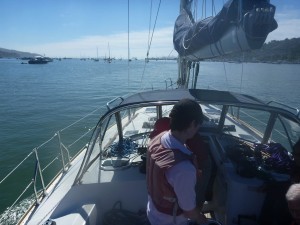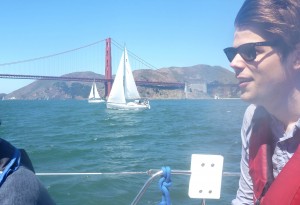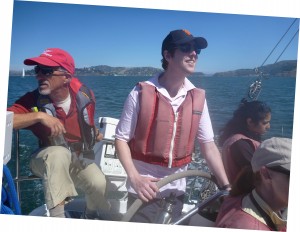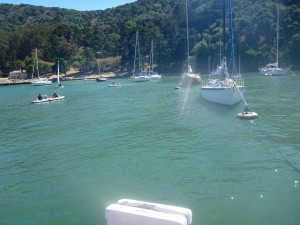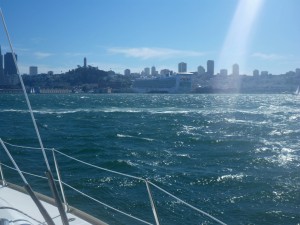While Mark and Anton went through the checklist (extensive since Bear Boat is equipped for offshore sailing) I climbed around the boat trying to get familiar with the equipment. It’s not a complex boat to sail, but there were still some surprises in store. I didn’t try to get familiar with the electrical system or the heads.
Soon, we cast off, and Mark motored us out while Anton and I cleaned up docklines and fenders. Reaching more open water, we raised the mainsail and rolled out the jib. Some of the non-sailors took turns at the wheel as we sailed across the bay to near Crissy Field and then tacked under the Golden Gate Bridge. The boat is equipped with top-of-the-line, two-speed, self-tailing winches, including a pair of winches on each cockpit gunwhale, either for the jib sheets or maybe for a spinnaker, too. But we quickly found the forward jib winches were not easy at all to use. We switched to using the aft winches, and found them difficult, too. It was only later in the day we realized part of the problem with the aft winches is they’re tailed aft, toward the helm position, as if for single handing, so they can’t be operated easily from the cockpit. There’s probably some logic for that set-up, but I never did figure out how to use the winches effectively. Also, all of the lines on the boat require a huge amount of effort. You pretty much can’t do anything without resorting to winches, and even with the winch, the loads can be so high that the winch isn’t enough. For example, if you don’t get the jib in right away on a tack, or if you need to head up, there’s simply no way to get the jib all the way in. The main sheet and main halyard also have very high loads. The reefing outhauls are more manageable, but they use such thin line that the winch can’t get a good grip, and they’re hard on the hands.We reefed the sails at one point. We assumed the mainsail reefing lines carried through the luff and leech cringles, as on the Beneteau 42 I sailed earlier in the week. That was dumb, because we could clearly see the luff had reefing rings, but still we didn’t send anyone forward to hook them on. It was half an hour before Anton pointed out the luff was loose. I went forward and unsnapped the sail cover from the mast, at which point I could see the reefing hook. So we eased the halyard, hooked the ring, and raised the main again. That made the luff happier, but it turned out later we still hadn’t sorted out the details of reefing. Anyway, I just don’t see why they lead the reefing outhauls to the cockpit, but still make you send someone forward to reef.
We sailed under the bridge, then turned around and sailed on a broad reach, tacking and jibing a few times, over to Angel Island, where we dropped the sails and motored into Ayala Cove to pick up a mooring. There were lots of boats moored already, but still several spaces open. Mark motored us past the mooring while Anton tried Mark’s new “Happy Hooker” mooring gizmo to pass the stern line through the ring on the mooring ball. (That gizmo is impossible to figure out. I still can’t quite work out how it works.) It took several tries. I’ve never learned to pick up a mooring, so each time, when Anton passed the stern line to me, I stumbled around while Mark and Anton tried to tell me what I should be doing. On the last attempt, with the deck already slick from water and slime picked up by the line on previous attempts, I slipped trying to move from the shrouds back to the stern and fell hard, landing on one of those damn jib sheet winches. I managed to get a foot on the toe rail and stay on the boat, and I held on to the mooring line, so I was able to get up and go back to try to cleat it off once the boat stopped.A big part of why I slipped is that the gunwhale is sloped outboard, so that it presents a level windward seat when the boat is heeled. That’s right, the boat is designed to favor sitting on the windward rail over moving safely around. OK, good to know, but it didn’t exactly endear me to the design.
The line I was holding was 150 feet of floating nylon line Mark had just bought, but he only bought one, so Anton had a shorter dockline up at the bow, trying to hook it on to another ball. I had to let the stern line go the first couple of times, because the bow line either wasn’t quite long enough or Anton couldn’t get it rigged in time. This time, I was able to hold onto the line and stop the boat, never a good idea. I got the line around the cleat and started springing the boat a foot at a time back toward the stern mooring to tighten everything up. It was a minute or two before I realized Mark had the engine in neutral. With a little reverse, we were quickly able to get the lines taught and hanging above the water.
Once everything settled down, we brought everyone’s picnic supplies up to the cockpit and had a relaxing lunch, watching several other boats moor even more inexpertly than we had.
After lunch, we motored out of the cove and up Racoon Strait to well off Angel Island, then raised the sails and sailed in increasing wind to near the San Francisco piers, where a huge cruise ship was docked. Before we got there, we had the main double reefed and the jib halfway furled. We turned around, and I took the wheel. I found I couldn’t point very close to the wind without luffing the jib. It was very frustrating. Then something on the boom started singing loudly. It had happened earlier, some sort of resonance we couldn’t identify, until Mark remembered he had heard it before, when the topping lift was too tight. We looked, and it was true: The topping lift was very tight, holding the boom higher than the leech of the sail wanted it.After a minute, I realized the topping lift was tight because the reefing outhaul was a bit loose. With some effort, Anton was able to tighten the reefing outhaul enough to bring the cringle down tight on top of a messy pile of sail that the lazy jacks had piled up in a heap on top of the boom. So, still not as tight as needed, but enough to ease the topping lift and allow the mainsheet to pull the leech down another six inches. That made a huge difference, as I was able to keep the jib and main filled while pointing a bit higher, as the wind climbed over 30 knots.
Still, the boat was heeling too much, so we furled the jib. But under just the main, and with the wind down to only 20-25 knots in the lee of Alcatraz, we slowed to a crawl. So we unfurled just a scrap of jib, and that was enough to bring us back up to six or seven knots through the water.
So, double-reefed main and a scrap of jib, and the boat was happy and moving in 20-30 knots of wind. I guess the designers felt the rest of the sails were needed for light winds, but there’s way too much sail area for San Francisco Bay.
As we closed in on Sausalito, Anton took the wheel to motor in while Mark and I readied docklines and fenders. Anton turned smoothly into the slip, and Mark and I stepped off to secure the docklines.
A very enjoyable day, even if I did come away with several bruises, sore muscles, and an even stronger belief that these larger cruising boats are not at all to my liking. I mean, OK, we carried nine people in relative comfort and had enough room in the cockpit for everyone to have lunch. But I think I’d rather have a boat that doesn’t overpower its own equipment, much less me.
I hear a junk rig is far easier to manage …


